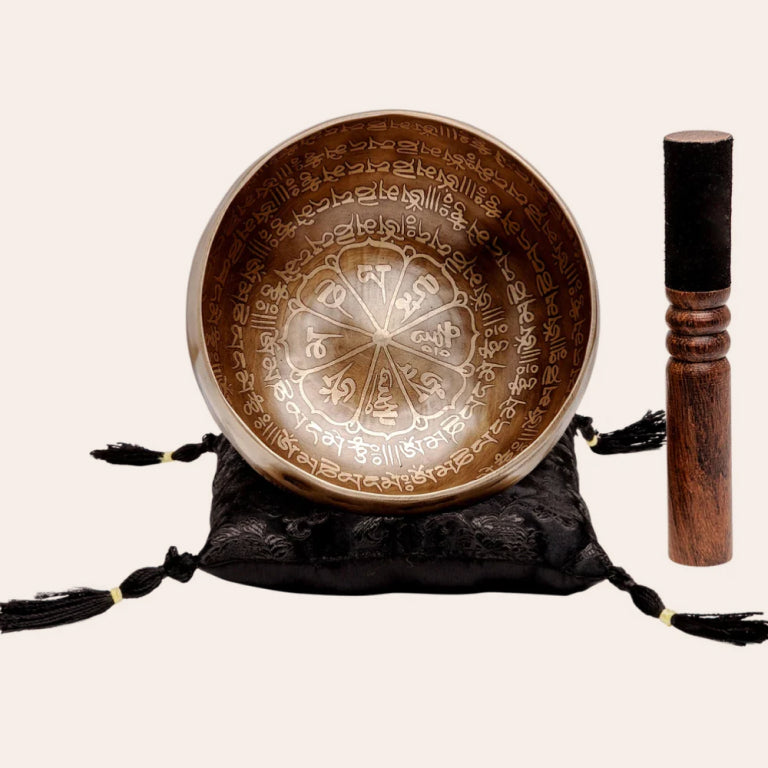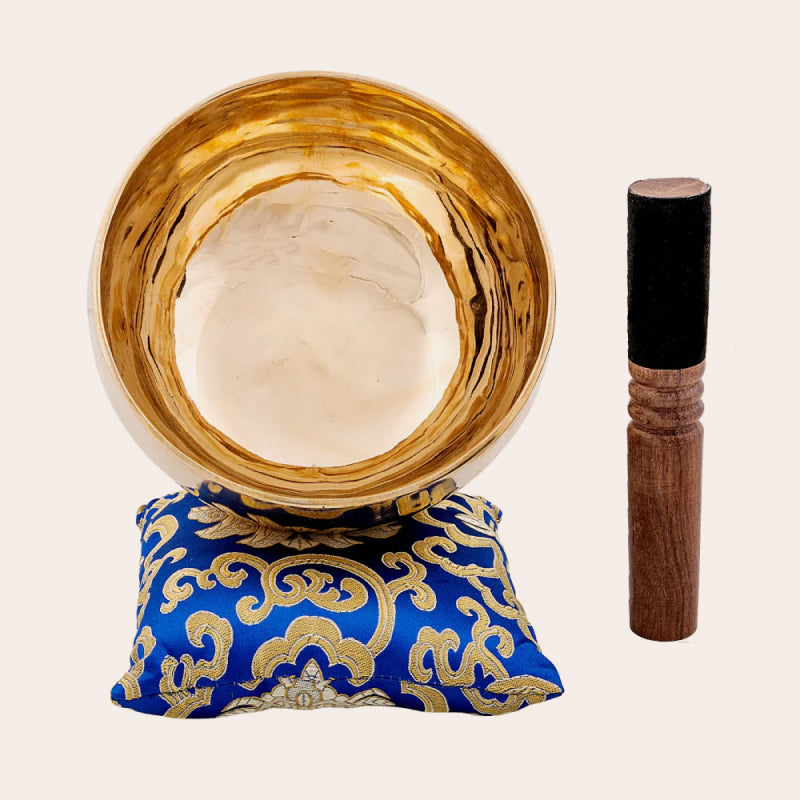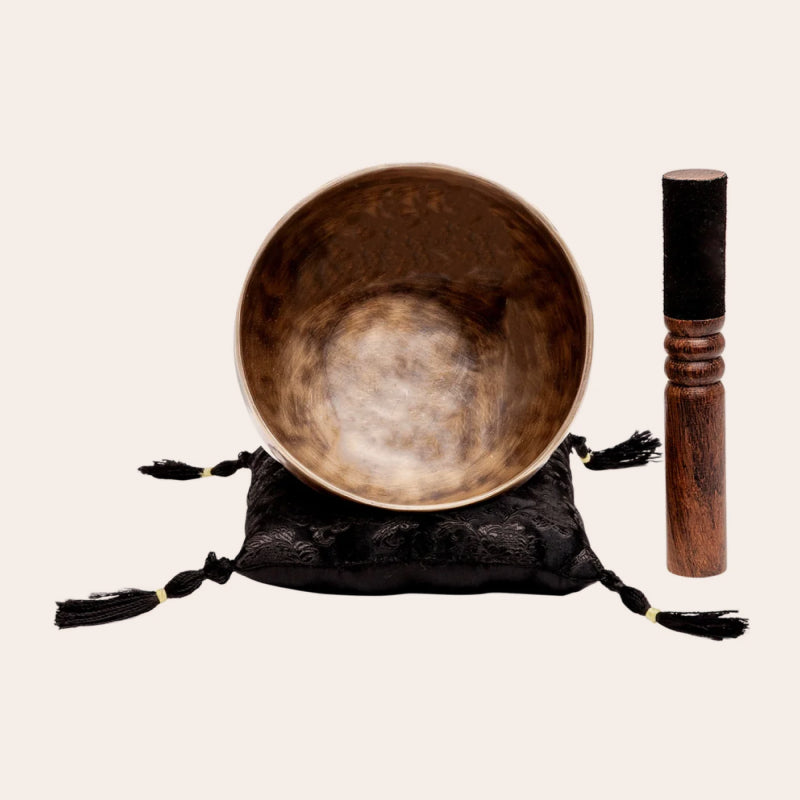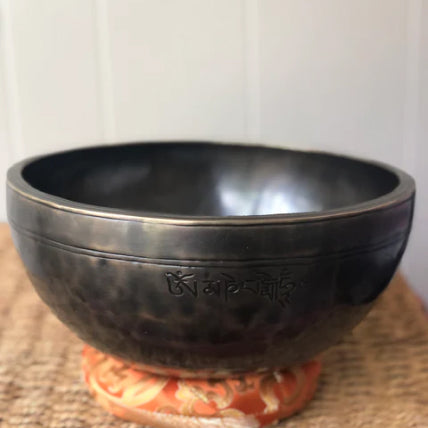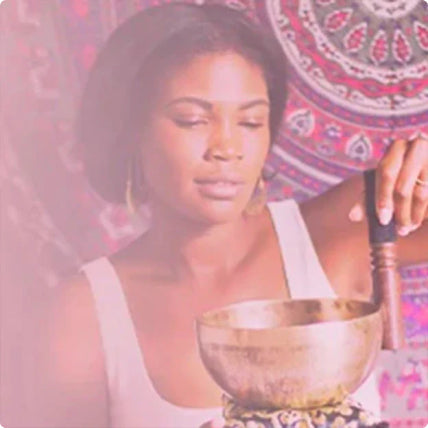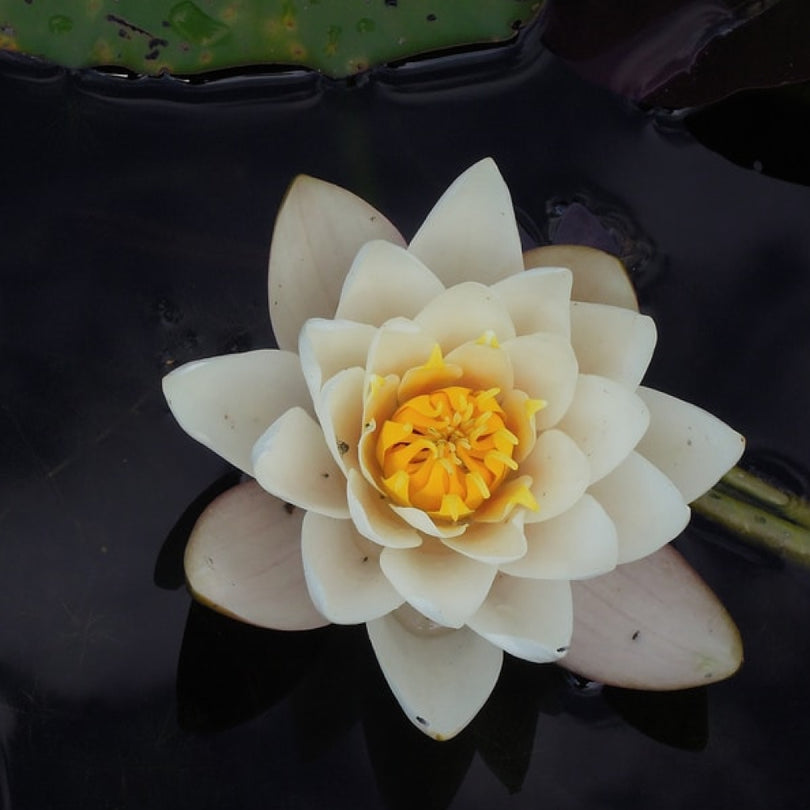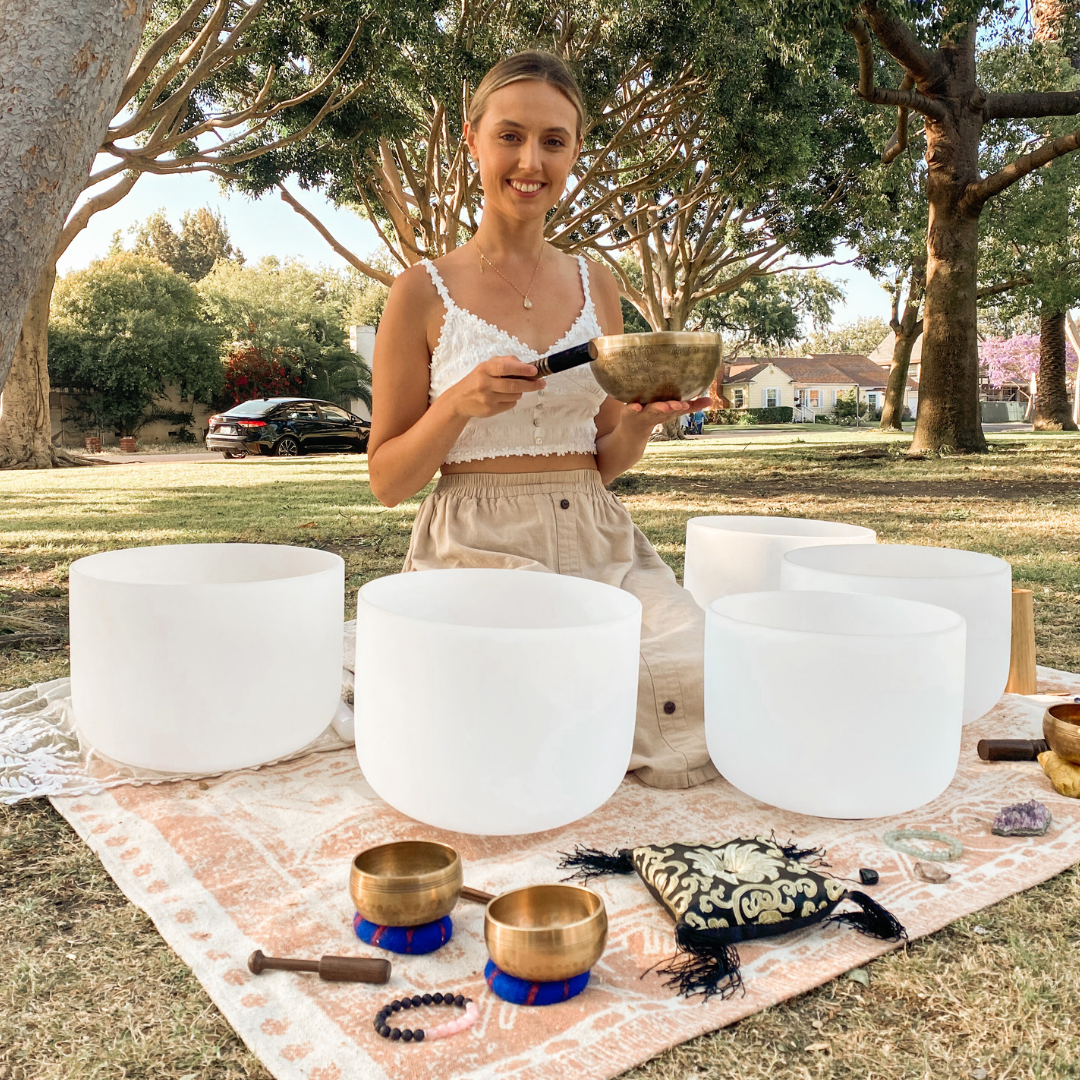You've noticed this Sanskrit mantra on several singing bowls and wondered - what is this all about?
Kudos to you for looking further! Om Mane Padme Hum is one of the most essential Buddhist mantras; it's believed to encompass the entirety of Buddha’s teachings.
But, what Does Om Mane Padme hum mean? Where does this originate? Why do we put it on our singing bowls?
Om Mane Padme Hum means ‘the jewel in the lotus’ and ‘awakening.’ It’s a condensed form of thousands of Buddhist mantras. When you chant this mantra and meditate upon it, it’s meant to uplift you from the depths of your confusions, anger, jealousy, hatred, and other negative traits, into the enlightened one like the Buddha.
In this article, we will describe its meaning, origin, and benefits.
What’s The Meaning Of Om Mane Padme Hum?
The short answer --it means "the jewel in the lotus."
The Sanskrit mantra dwells on the purity of a lotus flower as it emerges from the murky depths of a pond without a speck of dirt.
But, the jewel in the lotus could also signify Buddha.
That’s why the exact meaning of this mantra is hard to pinpoint as there have been so many interpretations, just like any other ancient text.
In fact, every syllable of the mantra signifies a different stage of purification.
- Om cleanses your body.
- Ma cleanses your speech.
- Ni cleanses your mind.
- Pad cleanses your emotions.
- Me cleanses your subconscious.
- Hum cleanses your veil of wisdom.
This mantra could be written in several forms like ommane padme hun, om manepadmi hung, and om mani padme hung too.
Decoding Om Mane Padme Hum In Detail
The Sanskrit mantra is called the six true words by monks.
Around Tibet, it’s written as- Om ma ne pad ma hum. It’s the ultimate mantra to purify your mind, body, and spirit into becoming a Buddha.
No wonder you’ll be greeted by this very mantra engraved on everything from rocks to yak skulls to prayer beads. You'll see it on most walks in the Buddhist areas of Tibet and Nepal.
Let’s decode the six true words individually to get a bit deeper.
OM
The first sound or syllable in the mantra is Om. While many theories exist, the most fascinating is: Om is the sound of creation itself.
Hinduism believes our universe was born with a big bang of the resonant sound of Om/ Aum. That’s why Aum represents the oneness of the mind, body, and spirit.
According to Buddhism, Om is the best mantra to clear your ego. It’s the sacred sound that emerges from the Samsaric God realm (this is the realm of heaven that exists above you).
So, Om stands for you- the practitioner of the mantra. It encompasses your unclean mind, body, speech that turns into the immaculate mind, body, and speech of a Buddha when you cleanse with the rest of the mantra.
Mane
Mane or Mani, on the whole, signifies jewel.
To understand it clearly, let’s split this word into ma + ni.
Ma lives in the Samsaric Realm of the Jealous Gods (The realm of Asuras). It intends to dissolve envy and our own affinity for material diversions. So, if you recite this syllable constantly, it’ll release you from the jealous and possessive bonds to nurture a selfless form of morality.
Ni denotes the Samsaric Realm of Humans (The Realm of Human Beings). It’s a chant to absolve the humane conditions of lust and desire. That’s why when you repeat this mantra time, and again, it’ll free you of the mortal coil of humanity to assimilate patience.
Padme
Together, the two syllables in the word imply ‘lotus’, indicating ‘wisdom’ and ‘knowledge’.
But when you split the word into pad and me, the meaning gets even clearer.
Pad exists in the Samsaric Realm of Animals (A lower realm of the beasts). It’s meant to resolve the pain, and suffering of the material world. That’s why humming this syllable improves your endurance and tenacity.
Me stands in the Samsaric Realm of Hungry Ghosts (A lower realm that indicates pretas or wandering ghosts). When you chant the mantra ‘me’ over and over, it’ll shake off the loop of insatiable and frustrating desires to help you concentrate on higher morals within yourself.
Hum
The single syllable hum or hung refers to invincibility. Existing in the Samsaric Realm of Hell (A lower realm of torment). Note that in the six Samsaric realms, the Hell Realm is a chaotic place filled with our regrets, anger, hatred, and pity.
So, if you chant this syllable frequently, it can free you from the clutches of aggressive thoughts to ground you and lead to enlightenment.
History Of Om Mani Padme Hum: From Where Does It Originate?
The earliest report of the mantra goes back to Tibetan sutras (Buddhist scriptures) that existed between the 4th century and early 5th century called Kāraṇḍavyūhasūtra Sutra (translated as The Basket’s Display).
It says the verse Om Mane Padme Hung is the most valuable or enlightening mantra that sums up all of Buddha’s teachings. Kāraṇḍavyūhasūtra refers to this mantra as the total of 84,000 dharmas (universal doctrine).
Perhaps that’s why the mantra has several variations to it. It could also mean ‘The jewel is in the lotus’ or ‘Hail the jewel in the lotus’.
Tibetan monks also call it a mantra to invoke the deity of Manipadmi that denotes the wisdom of Buddha. Hence, the mantra is also called ‘she of the jeweled lotus’.
As a side note, consider that lotus is very sacred to Hinduism. Every primary chakra is represented with a lotus of varied petals.
Wondering about the pronunciation of the mantra?
Check out a native speaker saying it! - Om Mani Padme Hum: How Tibetans Say It
Why Is Om Mane Padme Hum Used In Singing Bowls? What Are Its Benefits?
This is one of the only mantras seen on singing bowls, prayer beads, rings, bracelets, and plaques, amongst other things.
Here’s one of our favorite singing bowls with this mantra.

This one is called our Ancient Self Ohm Singing Bowl.
But why? Om Mani Padme Hung is engraved on bowls as a tradition because it emphasizes the spiritual meaning it aims to immerse you in.
By inscribing the mantra on singing bowls, the practitioner is encouraged to chant it. That’s because the mantra awakens the Avalokiteśvara, or the Buddha of compassion.
When you recite the Sanskrit mantra Ommani padme hung, it empties your body and mind.
But this emptiness doesn’t denote the traditional meaning of nothingness but the abandonment of ego. In Buddhism, ‘emptiness’ is a vast sea of possibilities.
As Buddhism advocates that the achievement of Buddhahood exists within and not the outside, the mantra fires up your spirit to the unconditional virtues and inner truths within yourself.
There are many more things you can do with this mantra.
The best use is chanting it for meditation and manifestation. It helps you reach awakening or bodhi, several samadhis where you transcend into higher consciousness and garner infinite karma.
Additionally, reciting om mane padme hum is equivalent to reciting thousands of mantras. That’s why it can even help you see the thousand-fold avatar of Buddha too. It also says you’ll take rebirth as one of the several realms within the body of the bodhisattva.
How To Soak In The Meaning Of Om Mani Padme Hum
Mantras are the word for holy chants in Sanskrit. The Buddhist mantra of om ma ne pad me hum is often seen on singing bowls to stimulate your mind to enter awakening, purity, and divine wisdom of the Buddha.
The current Dalai Lama says reciting the mantra is excellent, but meditating on the six true words is vital to achieving purity.
We become the lotus flower that attains supreme beauty after growing up from the muck by shaking off our impurities by meditating upon this mantra. Next time you’re playing the singing bowl, try meditating on this thought and share what you feel with our community here!

